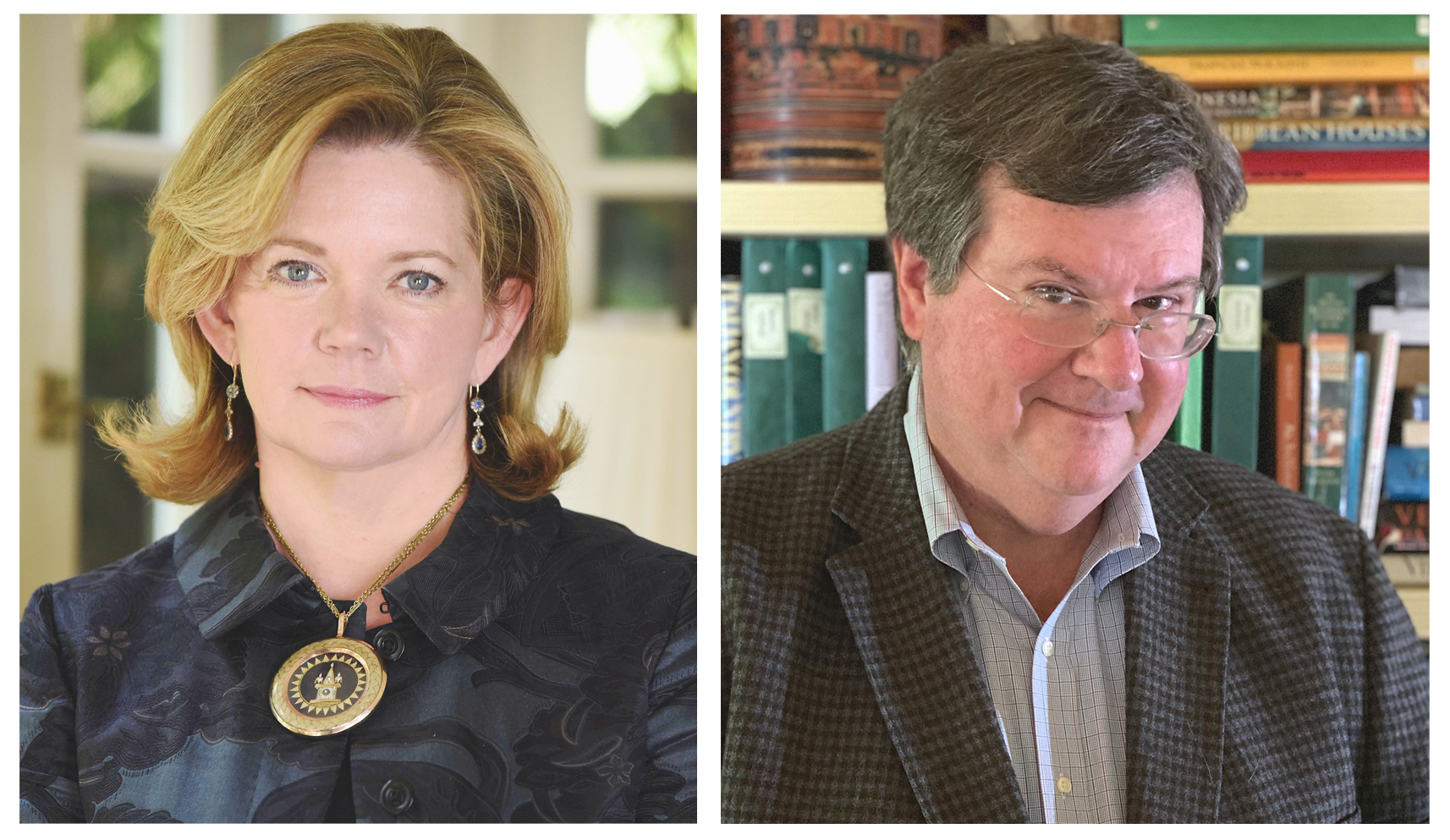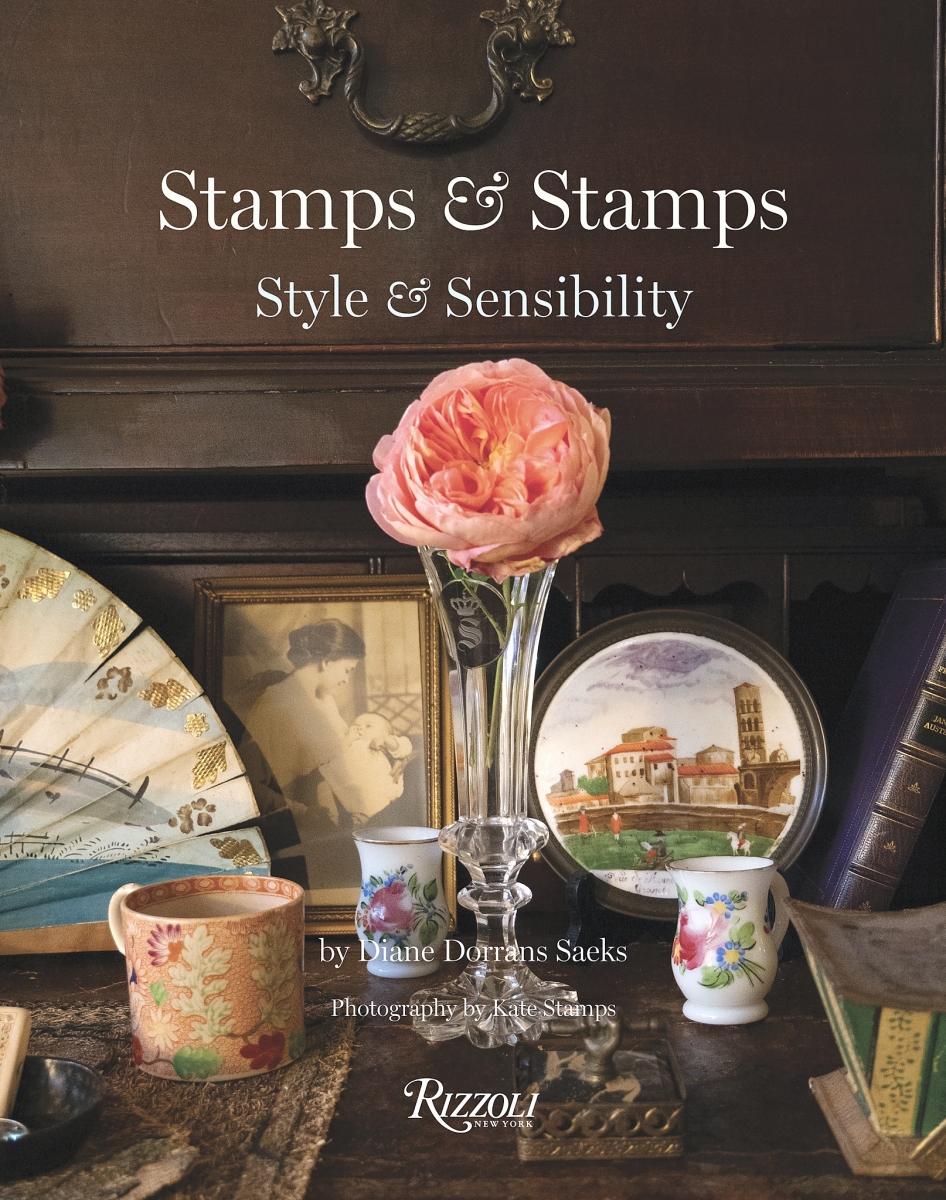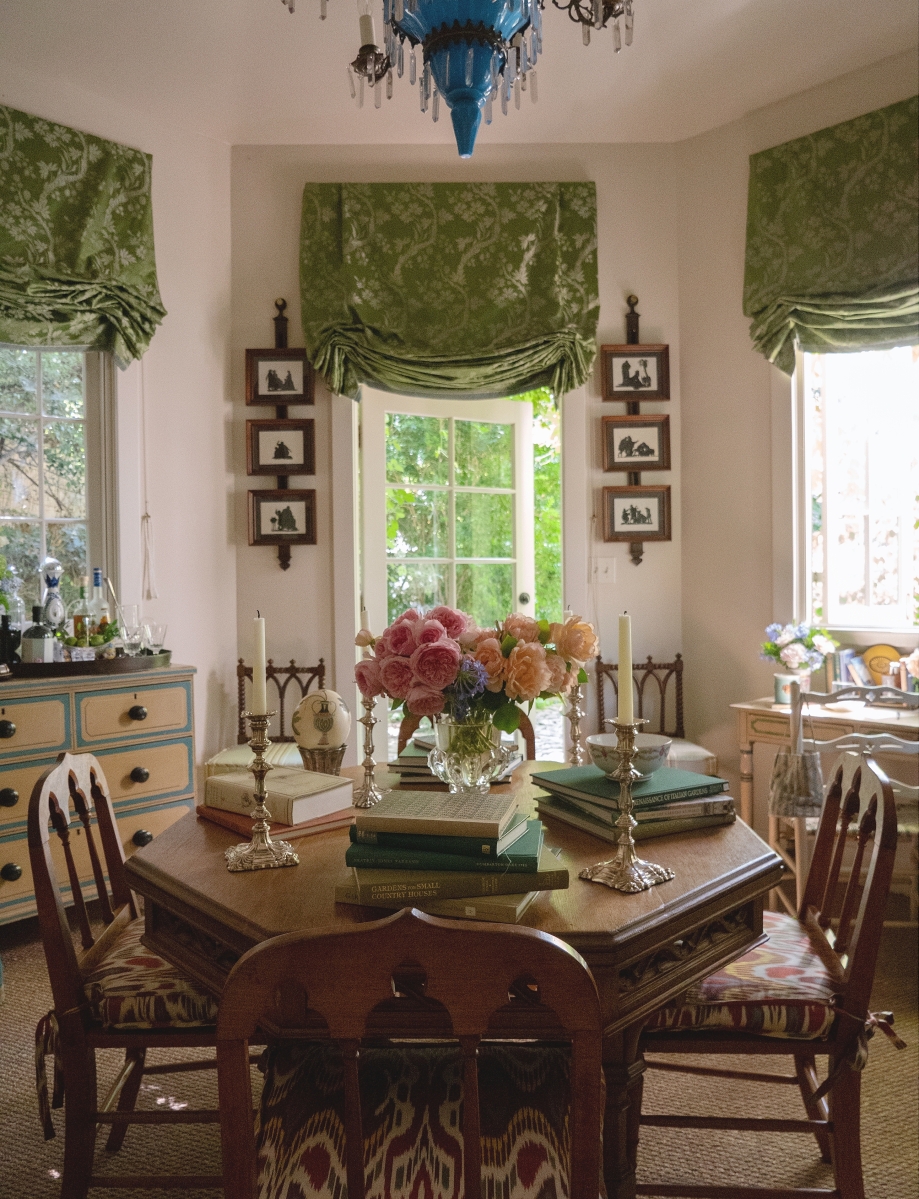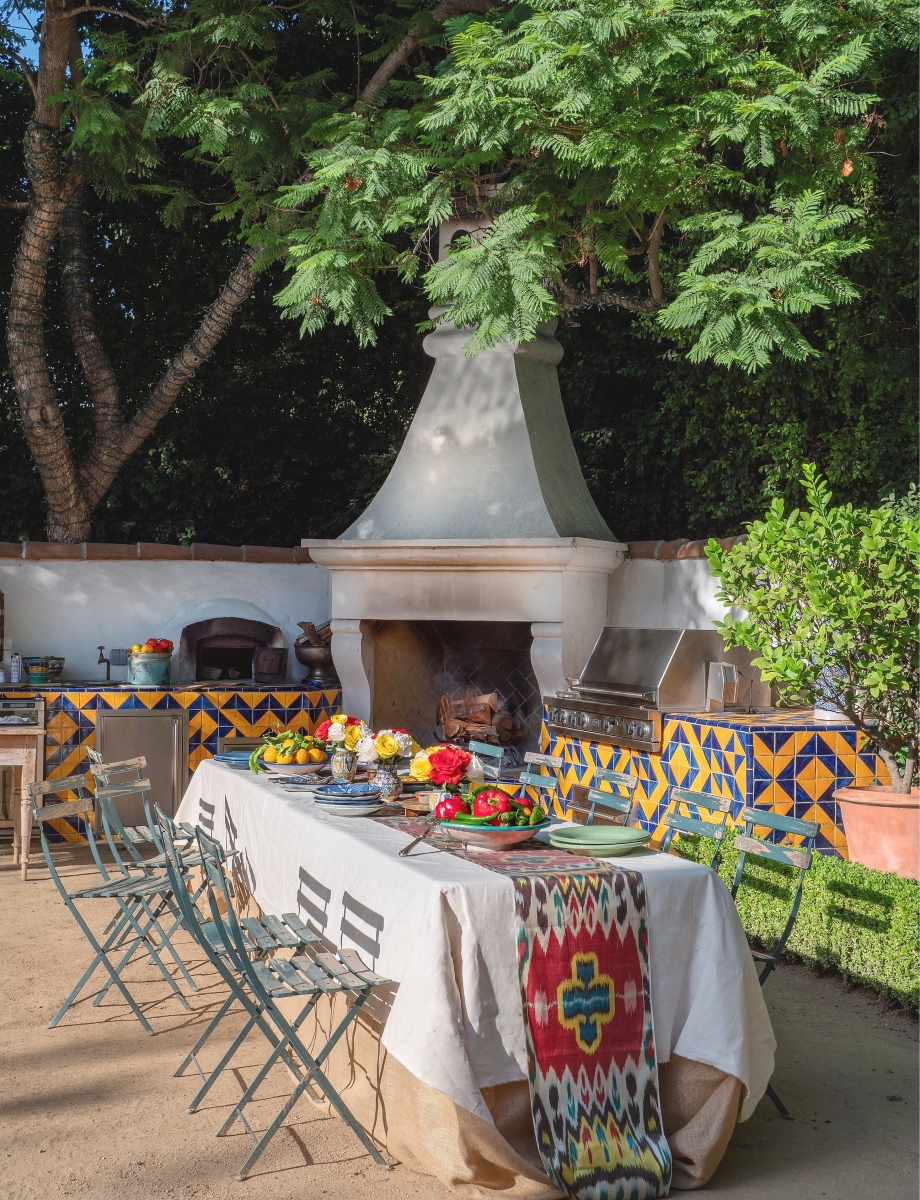Founded 20 years ago, the Stamps & Stamps design firm specializes in the creation of traditional English-inspired interiors. It is their philosophy that all three aspects of residential design – architecture, interiors and gardens – should be conceived together to create a coherent and intelligent home. In their first book, Stamps & Stamps: Style & Sensibility, Kate and Odom Stamps share their passion for historical references and attention to detail. On the evening of its release from Rizzoli, we reached out to the Stampses for insight into the book and what inspires them.
After 30 years in business, what prompted the book?
Several things. Our good friend, Diane Dorrans Saeks, knowing our work and having seen our photographs on Instagram, suggested that she would like to bring a proposal to Rizzoli, for whom she has written many beautiful books. Since I (Kate) had been taking photos of our projects for several years, we had hundreds of images with which to work, so we started there. We also had a great desire to try to help push the design pendulum back towards a more thoughtful and educated space, hoping that we could help by showing how livable and warm rooms can be when designed and decorated with a mix of things that includes antiques.
How long did the process of putting this book together take?
Well, we started really quickly, and finished very slowly. We have been working on some marvelous projects over the last few years, and Diane was familiar with our postings of some of them on our Instagram account. She suggested we should make a mock-up of the book as we envisioned it, with some of those images as well as pictures of our house, garden and guesthouses. When completed in April 2019, she took our proposal to Rizzoli, where our editor Ellen Nidy and publisher Charles Miers accepted the book. That is how Style & Sensibility became a reality and Kate became a professional photographer. With some lessons and tutorials and new equipment, Kate set out to document the projects, and we were on our way.
Because the publication date was September 2020, our deadline for photography and text was November 2019. This made for a very hectic shooting schedule! Of course, the pandemic changed everything, and in June 2020, we all agreed that the book should be released later, so we continued working with Diane and Ellen and our fabulous art director, Paul McKevitt, to polish the book, which has now been printed and will be in bookshops on April 6. Even with the delay, it was a fast-moving project.
In any design project, what is always your first step?
Most of our projects start with the architecture of the building, whether it is from the ground up, or a renovation. And from there, we look at context, neighborhood and of course the stylistic preferences of our clients. The decorating always ties into the structure, so that the house feels authentic and natural. If the home is in a traditional style, we often use reclaimed materials and architectural details like salvaged stone, wood and tile floors, antique chimney-pieces, antique interior doors and wall paneling. After the skin and bones of the house are in place, we always draw scaled floorplans and lay in furniture and upholstered pieces, the layers of pattern and color and texture added as we go. It is both an ordered and organic process, but one where we hope always to end up with an integrated, beautiful, profound house.
A lot of people think of the Midcentury Modern aesthetic when they think of Los Angeles. Is that an unfair reputation?
No, it isn’t unfair at all. We have Case Study houses, plenty designed by Cliff May and John Lautner, Frank Lloyd Wright, Richard Neutra and many other leading modernists, all designed and built during a period of great expansion and cultural exploration in Southern California. But we also have wonderful examples of Victorian, Deco, Craftsman, Transitional Shingle Style; LA is a bit of an architectural playground in which to work. One day we are working on a grand Georgian revival plan, and the next we may have a Moorish style riad on the boards, filling it up with wonderful, sybaritic seating and water features and courtyards, and then after that, a rangy Craftsman or a Cape Cod saltbox to modernize and make more comfortable.
And then, of course we do modern houses as well. The themes that flow through each one of the houses we do are those of integrity, comfort, authenticity, sensibility, proportionality, charm and character, regardless of style.
Do you try to incorporate antiques into modern interiors or have you done interiors that are exclusively modern?
There are always some wonderful antique things in every interior we do. Modern rooms benefit from the inclusion of antiques, and traditional spaces are kept fresh by the use of interesting objects of every age. Really, our rule is to not use reproductions. Occasionally that rule gets broken. For example, we often choose newly made dining room chairs from Howe London, as the Eighteenth and Nineteenth Century ones we love don’t stand up to modern everyday usage. Howe’s chairs are made to the standard of the old ones, in the same meticulous craftsman tradition. But generally, there is no reason to use reproductions when the real thing is available at a reasonable price. We work hard to find truly beautiful things from private sources, antiques dealers and auctions, things that are wonderful in themselves that will make every room interesting. Antique and ethnic textiles go everywhere, too, and add richness and complexity without fussiness.
Some of the best antiques for modern houses are the austere, dark English case pieces of the late Seventeenth and early Eighteenth Century. They are often large in scale, and without ornament. They mix beautifully with all of the sculptural forms of the Twentieth Century designers we love, from Finn Juhl, Arne Jacobsen, Verner Panton, Poul Henningsen to more contemporary and artist created furniture. In every age, there are those who take the decorative arts closer to fine art.
The key for us is to make a room compelling, comfortable and thoughtful enough that it can last for a lifetime. Characterless, stiff and ordinary is as boring in a modern house as it is in a Georgian mansion. In every space, our goal is to create a place where one feels completely at home in a personal, human and authentic way. The same rules apply when working in a contemporary house as they do when working in a conventional or historic home. Rooms that look good in photographs but don’t live well and congenially are not interesting to me. Staying power, timelessness, style, however you choose to define it, is the basic building block of our design. I suppose we define it as sybaritic aestheticism. If a place is full of fine and expensive pieces that make you feel like you are living in a museum, then it is a failure. Pretension has no place in a really cultured life, but refinement does. Rooms are for living, not just looking.
Since the pandemic began, auctioneers we have interviewed in our routine auction coverage have reported an increased interest (and prices paid, accordingly) for traditional antiques. Have you witnessed that?
Yes, definitely. We think the changes to lifestyle wrought by the pandemic have touched most people who are spending many more hours in their houses and they are finding them uncomfortable and boring. If it used to be that one spent eight hours in bed and then left for most of the hours of the day for work and family activities, coming home just to eat and go to bed again, we don’t think one might notice that that house was basically unpleasant and static. And since the auction houses have become more retail and more online friendly, it is very easy to point and click and find yourself the proud owner of some really lovely things that make your everyday life better. We will be interested to see how the auction houses learn to deal better with shipping issues and the tempers of retail customers, though. All of the dealers and decorators we know are definitely using auction houses more frequently, too, so the prices will rise.
What are your hopes for this book?
Well, of course we hope it does really well, but the idea of adding to the historical design library is most appealing to us. Books are friends and companions for life, and when we think of all the volumes on interiors and architecture that guided and informed us, that continue to inspire and influence us, we hope that we can bring that same wonderful frisson of excitement at entering another world by turning the pages of our book.
What are some of the books on interiors and architecture that have guided and informed you? Any books that you repeatedly return to for inspiration? Any recently published ones?
We are big book collectors and have been for many years. We would search out Interiors books about distant places, and our design library is still arranged by country. We love books on Eighteenth Century Scandinavian Design, interiors and architecture in Turkey, Italy, France, Morocco, the Caribbean, Spain, Central Europe, Russia, really any place where there is a great history of houses and their rooms. And of course, having spent so much time in England as a child and student, I fell in love firsthand with English design and decoration. John Cornforth’s books, several produced from the archives of the great magazine Country Life, and his The Inspiration of the Past, The Search for a Style, English Decoration in the Eighteenth Century, and The Quest for Comfort are all great classics. We search out folios and measured drawings of architectural detail published in the Nineteenth and early Twentieth Centuries and those are some of the great treasures of our library. The five volumes of New Orleans Architecture by Sam Wilson et al., published by Pelican Publishers are our most referenced favorites on the buildings of New Orleans. I suppose what these books have in common with all of the Cornforth books, and the books published from the annals of Country Life magazine is that they are all both academic and beautiful.
Of course, with the pandemic and the travel restrictions we are all living with now, books have become even more important, as armchair travel replaces our long taken for granted freedom to just get up and go. We have loved the three great Miguel Flores-Vianna books, Haute Bohemians, A Wandering Eye and Near and Far, which was written by Lisa Fine. We savor looking at The World of Madeleine Castaing, by Emily Eerdmans and the wonderful monograph on Jaime Parladé. Lulu Lyle’s book Rattan is fabulous, and Nathalie Farman Farma’s Decors Barbares and Inside Tangiers by Nicolò Castellini Baldissera are three of our other recent favorites. The list could go on and on, as books are something we never stop buying.
Editor’s note: Stamps & Stamps: Style & Sensibility will be released by Rizzoli New York on April 6. $50 hardcover.
-By Madelia Hickman Ring








